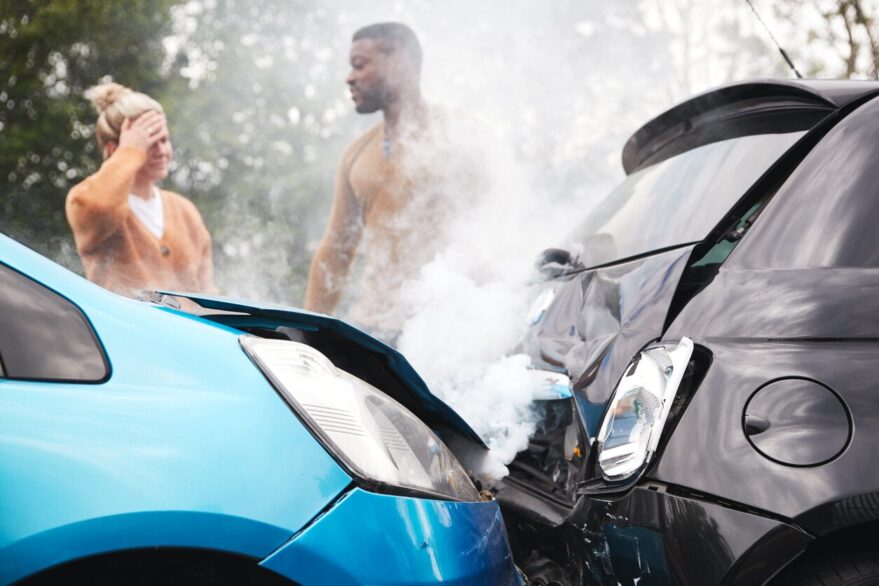What to Do if Your Car Starts to Skid

Skidding is one of the most frightening experiences a driver can face. It is especially terrifying on Colorado’s icy mountain roads. Sudden rainstorms and slick highways can also cause your car to skid. A moment of panic can make a dangerous situation much worse.
Knowing how to respond can help you regain control in a skid and prevent a car accident.
What Is Skidding in a Car?
Skidding occurs when your tires lose traction, often causing your vehicle to slide uncontrollably. This can happen because of sudden braking, sharp turns, or accelerating too quickly on slippery roads. When a car skids, steering and braking can become more difficult, increasing the risk of a crash.
In Colorado, skidding is common during:
- Winter months on ice and snow-covered roads
- Rainy days that create slick surfaces
- Areas with loose gravel or sand on curves and intersections
Understanding the risk factors and how to react when your car skids is key to staying safe on the road.
What Causes Skidding?
Several factors can contribute to skidding. Being aware of these causes helps you anticipate risk.
Reasons for skidding include:
- Weather conditions. Ice, snow, rain, and black ice reduce traction.
- Speeding. Driving too fast increases the likelihood of losing control.
- Sudden acceleration or braking. Abrupt pedal movements can trigger skids.
- Tire conditions. Worn tires make your car more prone to sliding.
- Road hazards. Oil spills, gravel, and debris can make traction unpredictable.
When you know the dangers, you can respond more effectively when your car starts to skid.
How to Regain Control if Your Car Skids
If your car starts to skid, the first step is to stay calm. Panicking can lead to overcorrection, which often makes the skid worse.
Instead, to regain control of a vehicle in a skid:
- Take your foot off the pedals. Don’t slam on the brake or gas pedals.
- Steer in the direction you want to go. If your rear end slides, gently turn the wheel toward the skid.
- Avoid over-correcting. Light, controlled steering prevents fishtailing.
- Use gentle braking if needed. Once your car regains traction, lightly tap the brakes to slow down.
Every skid is different. Adjust your response based on road conditions and the type of skid.
Front-Wheel vs. Rear-Wheel Skids
Drivers in Colorado should know whether their vehicle is front-wheel drive or rear-wheel drive.
Different skids require different techniques:
- Front-wheel skids. Often caused by braking too hard. Steer gently in the direction you want to go, and let the car regain traction. Avoid sudden movements.
- Rear-wheel skids. Typically caused by over-acceleration or slippery roads. Counter-steer carefully, letting the car straighten before returning to your lane.
Understanding your vehicle’s dynamics can make a major difference in knowing how to recover control.
Hydroplaning
Colorado’s climate presents some unique challenges for drivers.
These include:
- Hydroplaning. This occurs when a layer of water lifts your tires off the road, often at high speeds. Lift your foot off the gas, avoid braking abruptly, and steer gently in the direction you want to go.
- Black ice. This is a serious concern for winter driving in Colorado. Thin, nearly invisible ice is extremely dangerous, especially on bridges, in shaded areas, and at intersections. Watch for sudden changes in road texture or shine, and reduce your speed when conditions are uncertain.
Understanding and preparing for the unique driving challenges in Colorado can help reduce the likelihood of accidents.
What to Do After a Skidding Accident
Even minor skidding accidents can cause serious injuries.
After a crash, follow these steps:
- Check for injuries on yourself, passengers, and others involved.
- Call 911 to report the accident and get medical help.
- Move to a safe area if possible.
- Document the scene by taking photos of vehicles, skid marks, and road conditions.
- Exchange contact information and insurance details with other drivers.
- Collect contact information from witnesses.
- Notify your insurance provider.
Once you have followed these steps, contact a Denver personal injury lawyer for help evaluating your accident and helping you understand your next steps.
Contact Zaner Law Personal Injury Lawyers Today for a Free Consultation With Our Denver Car Accident Attorneys
If you or a loved one has been injured in a skidding accident in Colorado, don’t wait to seek help. Zaner Law Personal Injury Lawyers can help you recover compensation for your medical bills, lost wages, and pain and suffering.
For more information, contact the Denver car accident lawyers at Zaner Law Personal Injury Lawyers to schedule a free initial consultation with a Denver personal injury lawyer.
We are located in Denver, CO, proudly serving all of Denver County.
Zaner Law Personal Injury Lawyers
1610 Wynkoop Street, Suite 120
Denver, CO 80202
(720) 613 9706


